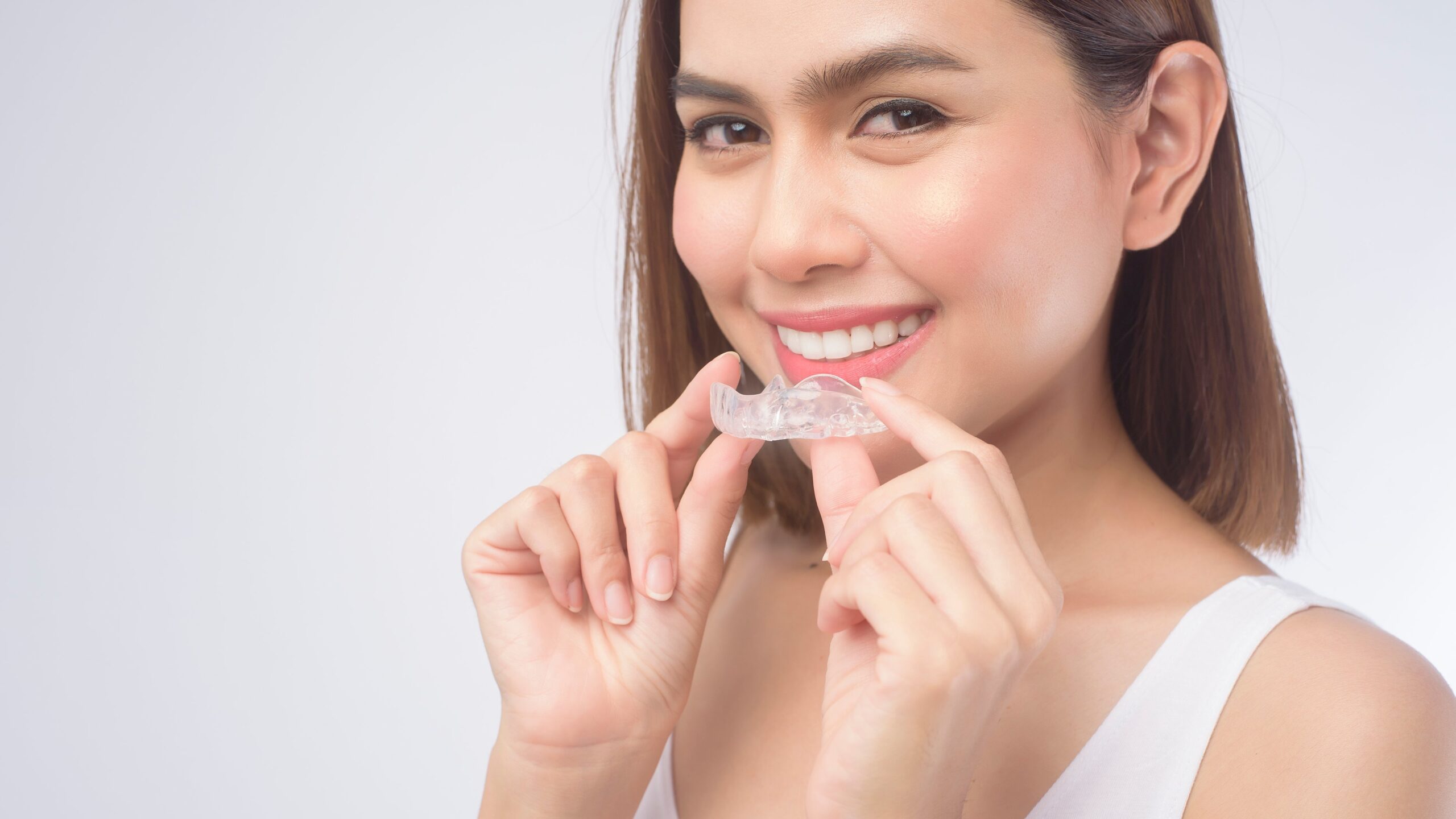Understanding Braces and Clear Aligners
In the pursuit of a beautiful smile, many individuals consider orthodontic treatments. These range from traditional braces to modern clear aligners. Understanding these options can help one make an informed decision on the best approach to achieve their smile goals.
Orthodontic Options
Orthodontic treatment options are designed to correct dental issues like crowded or crooked teeth, overbite, underbite, and jaw positioning problems. The most common types of orthodontic appliances include:
- Traditional Metal Braces: These use metal brackets and wires to gradually shift the teeth into the desired position.
- Ceramic Braces: Similar to metal braces but use clear or tooth-colored brackets to be less noticeable.
- Lingual Braces: These are placed on the inside surface of the teeth, making them invisible when smiling or talking.
- Clear Aligners: These are virtually invisible trays that fit snugly over the teeth to gently move them into the desired position.
Each option has its own set of pros and cons. The choice depends on the complexity of the dental issue, cost, treatment time, and personal preference.
How Braces Work
Braces work by applying continuous pressure to the teeth over a period of time to gradually move them into a new position. The orthodontist adjusts the tension at regular appointments, guiding the teeth into their correct placement. The process, while effective, can be uncomfortable due to the presence of metal wires and brackets in the mouth.
Benefits of Clear Aligners
Clear aligners for adults have emerged as a popular alternative to traditional braces. These offer several benefits:
- Aesthetics: Clear aligners are virtually invisible, allowing adults to undergo orthodontic treatment without feeling self-conscious.
- Comfort: Without wires or brackets, clear aligners are more comfortable than traditional braces.
- Removable: Clear aligners can be removed while eating or brushing, making these daily tasks easier.
- Predictable: A digital plan allows patients to see the expected results before starting the treatment.
| Orthodontic Option | Appearance | Comfort | Removability | Predictability |
|---|---|---|---|---|
| Traditional Braces | Visible | Less Comfortable | No | No |
| Ceramic Braces | Less Visible | Less Comfortable | No | No |
| Lingual Braces | Invisible | Less Comfortable | No | No |
| Clear Aligners | Invisible | Comfortable | Yes | Yes |
While clear aligners offer numerous advantages, they may not be suitable for all types of orthodontic issues. It’s always best to consult with an orthodontist to determine the most suitable treatment option.
Clear Aligners for Adults
Today, braces are no longer just for kids and teenagers. Adults looking to get a beautiful smile can benefit from orthodontic treatment too. One option that is particularly appealing to the adult demographic is clear aligners, often deemed a more aesthetically pleasing and convenient alternative to traditional braces.
Advantages Over Traditional Braces
Clear aligners offer several advantages over traditional braces. The most notable benefit is their near-invisibility. Unlike metal braces, clear aligners are virtually invisible, allowing adults to enhance their smiles discreetly. This is particularly important for working professionals who want to maintain a mature and professional appearance.
Another key advantage is convenience. Clear aligners are removable, which means they can be taken out when eating or brushing teeth. This not only makes maintaining oral hygiene easier, but it also means there are no dietary restrictions as with traditional braces.
The comfort factor also cannot be ignored. Clear aligners are custom-made to fit the patient’s teeth, reducing the discomfort often associated with the wires and brackets of traditional braces.
| Feature | Traditional Braces | Clear Aligners |
|---|---|---|
| Visual Impact | Visible | Near-invisible |
| Removability | Fixed | Removable |
| Oral Hygiene | Can be challenging to clean | Easy to clean |
| Dietary Restrictions | Food restrictions apply | No food restrictions |
| Comfort | Can cause discomfort | Custom-fit for comfort |
Suitability for Adult Patients
While clear aligners have many advantages, they may not be suitable for everyone. The effectiveness of clear aligners largely depends on the severity and type of orthodontic issue. They may not be the best option for complex orthodontic problems that require significant tooth movement or rotation.
Additionally, clear aligners require a high level of patient compliance. Since they can be removed, it’s up to the patient to wear them for the recommended 20 to 22 hours per day. Adults with busy schedules or those who may forget to wear their aligners might not see the desired results.
A consultation with an orthodontist is the best way to determine if clear aligners are the right solution for an individual’s orthodontic needs. By considering the pros and cons, as well as personal lifestyle and oral health, adults can make an informed decision about their path to a more beautiful smile.
Getting Started with Clear Aligners
If one is considering clear aligners for adults as a solution to aligning their teeth and achieving a beautiful smile, understanding the process is crucial. It involves an initial consultation followed by a custom treatment plan.
Initial Consultation
The first step in the process of getting clear aligners is an initial consultation with a qualified orthodontist. This appointment serves as an opportunity for the orthodontist to assess the patient’s oral health and determine the suitability of clear aligners for their specific case.
During this consultation, the orthodontist typically performs a comprehensive examination of the patient’s teeth and jaw. This may involve taking X-rays or digital scans to get a detailed view of the patient’s dental structure. Based on this assessment, the orthodontist can advise whether clear aligners would be an effective solution for the patient’s orthodontic needs.
The initial consultation also gives the patient an opportunity to ask questions and discuss any concerns they may have about clear aligners. The orthodontist can provide information about the process, including the estimated treatment duration, the cost, and the expected results.
Custom Treatment Plan
Once the orthodontist has confirmed that clear aligners are a suitable option for the patient, the next step is to create a custom treatment plan. This plan is tailored to the patient’s specific needs and goals, ensuring that the aligners will effectively move the teeth into the desired position.
Creating a custom treatment plan involves taking precise impressions or 3D scans of the patient’s teeth. These images are then used to design a series of clear aligners that will gradually shift the teeth over time. Each set of aligners is worn for about two weeks before moving on to the next set in the series.
Once the clear aligners have been designed, they are manufactured and delivered to the patient. The orthodontist provides detailed instructions on how to wear and care for the aligners, as well as what to expect during the treatment process.
The process of getting clear aligners involves careful planning and customization to ensure the best possible results. By understanding what to expect, patients can feel confident and prepared as they embark on their journey to a beautiful smile with clear aligners.
Day-to-Day Experience
Living with clear aligners for adults is a unique experience that involves certain practices for optimal results. This section will cover aspects of wearing clear aligners and their cleaning and maintenance.
Wearing Clear Aligners
The beauty of clear aligners lies in their discreet nature, making them a comfortable and convenient choice for adults. They are designed to be worn for the majority of the day (usually around 20 to 22 hours), only being removed during meals and for oral hygiene practices like brushing and flossing.
It is not uncommon for individuals to feel a slight discomfort or pressure when they first begin wearing clear aligners or when they switch to a new set. This pressure is a positive sign and indicates that the aligners are working to shift the teeth into the desired position. Over time, most users become accustomed to this feeling and the aligners become more comfortable to wear.
One key aspect of wearing clear aligners is regular check-ups with the orthodontist. These appointments are necessary to monitor progress and make any necessary adjustments to the treatment plan.
Cleaning and Maintenance
Proper cleaning and maintenance are vital to ensure the effectiveness and longevity of clear aligners. While aligners should be removed when eating or drinking anything other than water, they should be cleaned before being placed back in the mouth.
Cleaning clear aligners involves gently brushing them with a soft toothbrush and rinsing with lukewarm water. It is not advised to use toothpaste or harsh cleaning chemicals, as these can cause discoloration or damage to the aligners.
Additionally, it’s essential to maintain good oral hygiene when using clear aligners. Teeth should be thoroughly cleaned before the aligners are placed back in the mouth to prevent trapping food particles or bacteria, which could lead to cavities or gum disease.
In summary, the day-to-day experience with clear aligners involves wearing them for the majority of the day and maintaining proper cleaning practices. By following these steps, individuals can look forward to achieving a beautiful and healthy smile.
Progress and Adjustments
As an individual undergoes orthodontic treatment with clear aligners, it’s important to keep track of progress and make necessary adjustments to ensure the best possible results. This involves monitoring changes in the alignment of the teeth and adjusting the treatment plan as needed.
Monitoring Changes
During the course of treatment with clear aligners, patients need to regularly monitor the changes in their teeth alignment. This is typically done through routine check-ups with the orthodontist. These visits provide an opportunity to assess the effectiveness of the aligners and determine whether the treatment is progressing as expected.
The orthodontist will use a variety of tools and techniques to evaluate the alignment of the teeth, including visual inspection and dental imaging. They will look for improvements in the positioning of the teeth and check for any potential issues that may need to be addressed.
In addition to these professional assessments, patients can also keep track of their progress at home. By comparing the current state of their teeth to the initial alignment, they can get a sense of how much progress they’ve made. This can be encouraging and motivating, especially during the early stages of treatment when changes may be less noticeable.
Adjusting Treatment Plan
Based on the progress of the treatment, adjustments may be made to the treatment plan. This could involve switching to a new set of aligners, modifying the existing aligners, or incorporating additional orthodontic appliances.
If the teeth are not moving as expected, the orthodontist may recommend wearing the aligners for a longer period before switching to the next set. Alternatively, if the teeth are moving more rapidly than anticipated, the transition to the next set of aligners may be expedited.
In some cases, additional appliances may be used in conjunction with the aligners to facilitate the movement of the teeth. This could include rubber bands, bite ramps, or expanders. These tools can help to address specific issues and enhance the overall effectiveness of the treatment.
It’s important to remember that adjustments are a normal part of the process when using clear aligners. They are not indicative of a problem with the treatment, but rather a necessary step to ensure the best possible outcome. By staying in close communication with the orthodontist and following their recommendations, patients can achieve the beautiful smile they’ve always wanted with clear aligners for adults.
Achieving a Beautiful Smile
The journey to a beautiful smile with clear aligners involves several steps, from initial consultation and treatment planning to wearing the aligners daily and maintaining proper oral hygiene. However, the process doesn’t end with the removal of the aligners. Let’s explore what happens after the completion of treatment and the importance of the retention phase.
Completion of Treatment
The active phase of treatment concludes when the pre-determined alignment goals are achieved. For adults using clear aligners, this typically involves a series of aligners worn over a period of several months to a couple of years, depending on the complexity of the case.
At the final appointment, the orthodontist will carefully examine the patient’s teeth and bite to ensure that the desired results have been achieved. It’s essential for the patient to voice any concerns or dissatisfaction at this stage, as any further modifications would require additional treatment planning and possibly new aligners.
Once both the patient and orthodontist are satisfied with the result, the clear aligners are removed. The patient can now enjoy their new, straighter smile. However, the process doesn’t end here.
Retention Phase
After the completion of treatment with clear aligners, patients transition into the retention phase. This phase is crucial to maintain the results achieved during the treatment phase.
During the retention phase, patients are typically required to wear a retainer. This device may be similar in appearance to the clear aligners used during treatment or could be a fixed retainer bonded to the back of the teeth. The retainer is designed to prevent the teeth from shifting back to their original positions, a phenomenon known as relapse.
The duration and specifics of the retention phase can vary greatly among patients. Some may need to wear their retainer full-time initially, gradually reducing to night-time wear only, while others may be asked to wear their retainer only at night from the start. The orthodontist will provide personalized instructions based on the specifics of the patient’s case and the results achieved.
Adherence to the retention phase is as crucial as the active treatment phase for the long-term success of orthodontic treatment. Therefore, patients must follow their orthodontist’s instructions regarding retainer wear and maintenance diligently.
By diligently following through with the retention phase, patients can ensure that their newly aligned smile stays put, rewarding them with a lasting beautiful smile. Clear aligners for adults, indeed, offer a practical and aesthetically pleasing solution for achieving a perfect smile.






